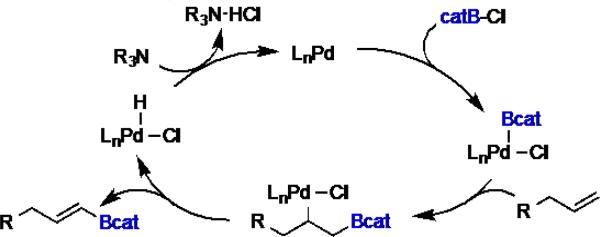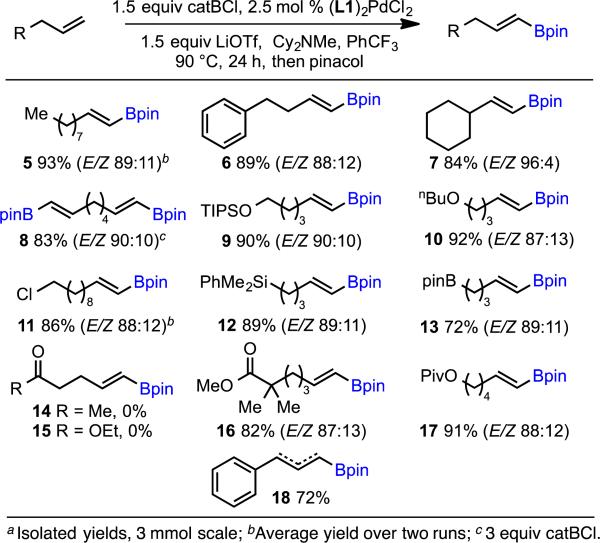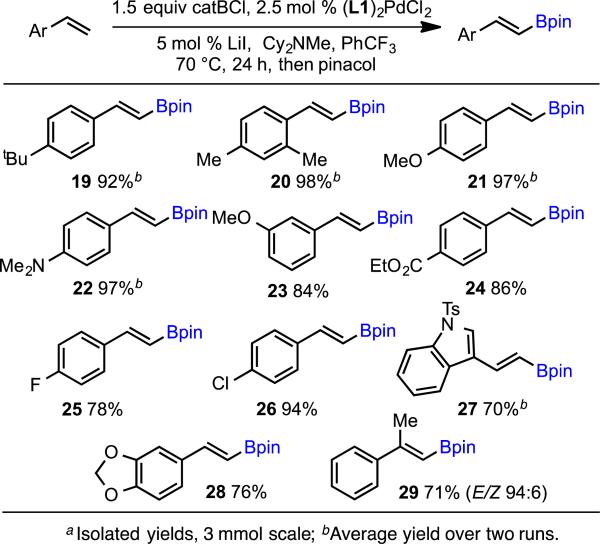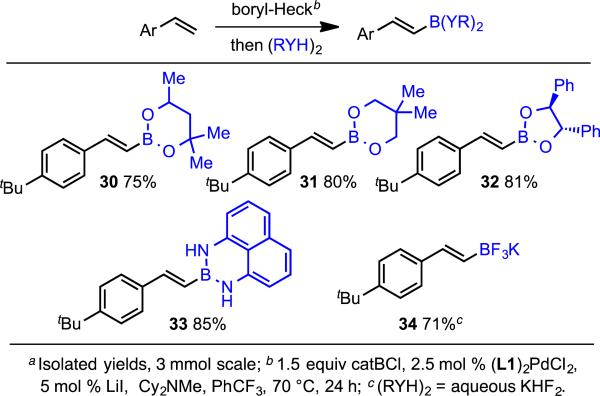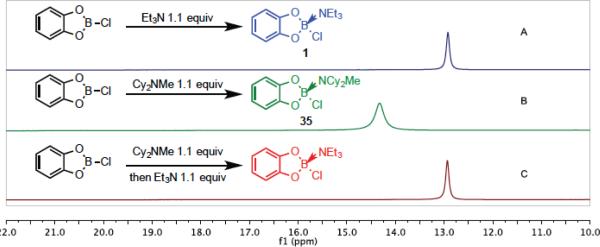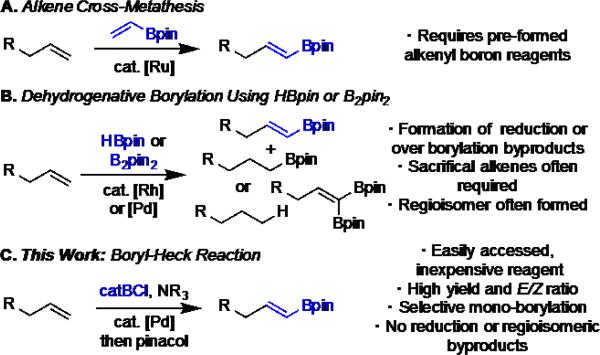Abstract
We report the first example of a boryl-Heck reaction using an electrophilic boron reagent. This palladium-catalyzed process allows for the conversion of terminal alkenes to trans-alkenyl boronic esters using commercially available catecholchloroborane (catBCl). In situ transesterification allows for rapid access to a variety of boronic esters, amides, and other high value alkenyl boron adducts.
Graphical abstract
Organoboron compounds are among the most versatile reagents in synthetic chemistry.1 Alkenyl boronic esters in particular have gained great interest in recent years, as they participate in a variety of transformations, including Suzuki cross-couplings1 and Petasis reactions.2 These reagents can also be used to forge C-O, C-N, C-F, C-Br and C-I bonds.3 Traditionally, these intermediates are synthesized via hydroboration,4 which requires access to the appropriate alkynes, or Miyaura borylation,5 which requires prefunctionalized alkenes. Both of these classes of starting materials are significantly more expensive and less commercially abundant than the corresponding alkenes, making methods for direct borylation of alkenes highly attractive for both economical and efficiency reasons.
Alkene cross-metathesis provides one route to convert terminal alkenes into alkenyl boronic esters.3a, 6,7 However, this method requires the preformed vinyl or 1-propenyl boronic esters, which require several steps to prepare from BCl3 or B(OMe)3 and are thus relatively expensive to buy or time-consuming to make.3a
A variety of rhodium- and palladium-catalyzed methods for direct borylation of terminal alkenes have also been explored using B2Pin2, HBPin, or related reagents.8 These methods are typically limited in scope (particularly with respect to linear α-olefins8a) and frequently suffer from competitive over-borylation,8b, 8d-f or alkene reduction/hydroboration.8c, 8g, 8h, 8i As such, excess or sacrificial alkenes as hydrogen acceptors are often required.8a, 8j-l Many of these problems stem from the use of highly reduced boron reagents. In addition, although some are commercially available, diboranes require several synthetic steps to access - and thus are relatively expensive.9
An alternative approach involves the palladium-catalyzed borylation of alkenes using chloroborane reagents via a Heck-like reaction (Figure 1). Such a boryl-Heck process would be advantageous, as the use of a more highly oxidized reagent would eliminate problematic reduction byproducts. In addition, the required chloroboranes are prepared directly from inexpensive BCl3 and diols.
Figure 1.
Boryl-Heck Reaction
Tanaka has established that oxidative addition of palladium to B-Cl bonds and subsequent migratory insertion into unsaturated C-C bonds (alkynes) is feasible.10 Suginome has elegantly utilized these steps in multi-component cascade cyclizations of chloroaminoboranes that lead to complex borane-containing products,11 and in one case has shown a bimolecular cascade involving alkynes.12 However, to date, a complete boryl-Heck reaction that converts an alkene to an unsaturated boronic ester using an electrophilic borane has not been demonstrated.13
 |
(1) |
In fact, Marder has previously suggested a boryl-Heck reaction.14 However, his preliminary studies showed that catecholchloroborane (catBCl) and Et3N (a common base in Heck reactions) form highly stable amine-borane adduct 1 (eq 1), which presumably prevents oxidative addition. He also showed that phosphines can both coordinate and decompose catBCl. Marder's results, along with Suginome's use of less electrophilic aminoboranes, illustrate the inherent difficulty of developing a boryl-Heck reaction to deliver a simple alkenyl boronic ester. Such a reaction requires both Lewis acidic chloroboronic esters and a base to turn over the catalytic cycle.
We have developed a palladium-catalyzed direct silylation of alkenes using electrophilic silanes (silyl-Heck reactions).15 This work inspired us to reinvestigate the analogous boryl transformation. Herein, we report the successful palladium-catalyzed borylation of alkenes using readily available catBCl as an electrophilic boron source. This transformation converts a wide range of terminal mono-substituted alkenes into terminal transalkenyl boronic esters with excellent regio- and stereoselectivity. The labile catechol group of the initial products allows facile transesterification to a variety of boronic acid derivatives. This reaction avoids problematic reduction and overborylation products, utilizes an inexpensive boron source, and most importantly, demonstrates for the first time that electrophilic borylating agents are compatible with a Heck-like catalytic cycle.
CatBCl is an attractive reagent, as it is commercially available and readily synthesized from BCl3 and catechol (both are abundant and inexpensive on-scale).16,17 Using this reagent, we initially explored borylation of 1-decene using conditions similar to our silyl-Heck protocol (20 mol % Cy3P, 10 mol % [(COD)Pd(CH2SiMe3)2], Et3N, PhCF3, 80 °C).15a We did not observe the desired borane, but only the amine-borane adduct 1 previously reported by Marder (Table 1, entry 1).14
Table 1.
Identification of an Effective Base

| |||||
|---|---|---|---|---|---|
| entry | base | 2 (%)a | 3 (%)a | 4 (%)a | E/Z of 4 |
| 1 | Et3N | 100 | 0 | 0 | - |
| 2 | none | 3 | 97 | 0 | - |
| 3 | K2CO3 | 4 | 96 | 0 | - |
| 4 | pyridine | 91 | 9 | 0 | - |
| 5 | 2,6-lutidine | 70 | 30 | 0 | - |
| 6 | iPr2NEt | 52 | 33 | 15 | ~90:10 |
| 7 | Cy2NMe | 65 | 9 | 26 | ~90:10 |
Yield determined by NMR.
We hypothesized that formation of amine-borane adducts could be disrupted by the use of a different class of base or by a larger amine that might form a less stable adduct. Without base or with inorganic bases such as potassium carbonate, nearly full isomerization of the starting material to internal alkene isomers 3 was observed (entries 2 and 3). Weaker organic bases, such as pyridine or 2,6-lutidine, suppressed isomerization but did not lead to 4 (entries 4 and 5). In contrast, with the larger trialkylamine Hünig's base, 15% of trans-alkenyl boronic ester 4 was observed (entry 6). With N,N-dicyclohexylmethylamine (Cy2NMe) even more of 4 (26%) was formed along with less starting material isomerization (entry 7). Importantly, in both entries 6 and 7, 4 was the only organoboron product; no internal alkenyl- or allyl-boronic esters were detected. In both cases, 4 was formed with high E/Z selectivity (ca. 90:10).
To optimize the reaction further, we turned our attention to the nature of the catalyst. In the absence of palladium and ligand, no product was observed (Table 2, entry 1). Using Cy3P as ligand, a broad range of palladium precatalysts provided similar yields of 4.18 Pd2dba3 was selected for further study (entry 2). Interestingly, Pd2dba3 without added phosphine yielded a significant quantity of 4 (65%, entry 3). Numerous other phosphines were examined;18 however, most were inferior to entry 3. For example, both Ph3P and SPhos provided poor results (entries 4 and 5). In contrast, the use of tBuPPh2 led to less alkene isomerization, albeit in similar yield as entry 3 (entry 6). We next examined phosphine L1, a ligand designed in our group for silyl-Heck reactions.15e,19 Somewhat unexpectedly, this ligand provided a notable increase in the production of 4 (82%, entry 7), even with only 5 mol % Pd (entry 8), and has proven to be the most effective to date.20 Even with L1, alkene isomerization of the starting material continued to erode the yield. To suppress this, we investigated the use of additives. The addition of 1.5 equiv of LiOTf fully suppressed starting material isomerization.21 With no competing isomerization, an increase in temperature was permissible, and a quantitative yield was achieved (entry 9). To further simplify the method, a single component catalyst (L1)2PdCl2 was developed.18 Using this air and moisture stable complex, quantitative yield of 4 was observed as a 88:12 mixture of E/Z alkenyl boronate isomers with only 2.5 mol % catalyst. Further studies also revealed that the single component catalyst provided more consistent results on preparative scale (Tables 3 and 4).
Table 2.
Optimization of Alkenyl Boronic Ester Formation

| ||||||
|---|---|---|---|---|---|---|
| entry | precatalyst (mol %) | ligand (mol %) | additive | 2 (%)a | 3 (%)a | 4 (%)a |
| 1 | none | none | none | 100 | 0 | 0 |
| 2 | Pd2dba3 (5 mol %) | Cy3P (20 mol %) | none | 53 | 15 | 32 |
| 3 | Pd2dba3 (5 mol %) | none | none | 0 | 35 | 65 |
| 4 | Pd2dba3 (5 mol %) | Ph3P (20 mol %) | none | 65 | 10 | 25 |
| 5 | Pd2dba3 (5 mol %) | SPhos (10 mol %) | none | 0 | 56 | 44 |
| 6 | Pd2dba3 (5 mol %) | tBuPPh2 (20 mol %) | none | 19 | 19 | 62 |
| 7 | Pd2dba3 (5 mol %) | L1 (20 mol %) | none | 2 | 16 | 82 |
| 8 | Pd2dba3 (2.5 mol %) | L1 (10 mol %) | none | 0 | 18 | 82 |
| 9b | Pd2dba3 (2.5 mol %) | L1 (10 mol %) | LiOTfc | 0 | 0 | >99 |
| 10b | (L1)2PdCl2 (2.5 mol %) | none | LiOTfc | 0 | 0 | >99 |
Yield determined by NMR.
90 °C.
1.5 equiv.
Table 3.
Scope of Linear α-Olefin Substratesa
Table 4.
Scope of Styrenyl Substrates
The scope was next examined (Table 3). To facilitate isolation, pinacol (3 equiv) was added at the end of each reaction, resulting in rapid, quantitative conversion of the products to more easily isolated pinacol boronic esters. Under these conditions, the product from 1-decene (5)was isolated in 93% yield with an E/Z ratio of 89:11. Other aliphatic alkenes were converted to alkenyl boronic esters with good yields and E/Z selectivities (6-7). Using 3 equivalents of catBCl, 1,7-octadiene was diborylated in 83% yield (8). A variety of functional groups were well tolerated, including silyl-protected alcohols (9), ethers (10), alkyl chlorides (11), silanes (12), and alkyl pinacol boronic esters (13). Although enolizable carbonyls interfered with the reaction (14-15, presumably due to competitive formation of boron enolates), non-enolizable carbonyls (16-17) did not. When allylbenzene was used as substrate, boronate 18 was observed as a mixture of alkene isomers. This is the only case where an allyl boronic ester was observed, which we attribute to the stability of a conjugated aromatic group.18
Substituted styrenes were also investigated (Table 4). Since starting material isomerization is not possible, LiOTf is not required. However, an examination of other additives showed that 5 mol % LiI accelerated the reactions, allowed for lower reaction temperature (70 °C), and led to improved yields.22 In the case of styrenyl substrates (except for 29), only E-alkenyl boronates were observed. 4-tert-Butylstyrene was converted to 19 in 92% yield. Sterically hindered (20), electron-rich (21-22), and electron-poor substrates (23-24) all gave good to excellent yields. Aryl fluorides (25) and chlorides (26) were well tolerated. Heterocyclic alkenes, such as indoles (27) and dioxolanes (28), were also excellent substrates. Significantly, α-methylstyrene was also borylated in good yield and with excellent E/Z selectivity (29).8c, 8d This product cannot be synthesized via hydroboration, and it demonstrates that increased substitution on the alkene may be accessible in future work.23
Different boronic esters provide different reactivity in a variety of transformations.1 This boryl-Heck reaction is readily adapted to produce diverse boronate derivatives by simply changing the nucleophile added after the reaction, delivering various boronic esters (Table 5, 30-32), amides (33), and trifluoroborates (34).
Table 5.
Synthesis of Alternative Boronic Derivativesa
On-going studies are aimed at elucidating the mechanism. At present we favor the Heck-like pathway outlined in Figure 1. Preliminary studies have revealed two key observations. First, with regard to the role of the amine, although the combination of catBCl and Cy2NMe (in CDCl3) does reveal formation of an amine-borane adduct by 11B NMR (Figure 2, 35), it is distinct from that formed with Et3N (1). The Cy2NMe derived complex is broader and more downfield, both of which indicate a less tightly bound boron atom. Further, addition of 1 equiv of Et3N to 35 results in complete conversion to 1, providing additional evidence for a less stable Cy2NMe complex. This data supports the notion that a greater concentration of free catBCl is available with the use of the larger base and explains our success when compared to earlier reports.
Figure 2.
11B NMR spectra of coordination complexes.
Second, selective formation of E-alkenyl boronates appears to be thermodynamic.24 The observed E/Z ratio is similar to that of earlier rhodium-catalyzed processes8l and closely reflects the calculated thermodynamic ratio of all possible allyl and alkenyl isomers.18 Experimental evidence for thermodynamic control was gained by spiking isomerically pure (E)-hexenylborane 36 into the boryl-Heck reaction of 4-phenylbutene (eq 2). Boronate 6 was formed with the expected E/Z selectivity, however 37 was found with only a 93:7 E/Z ratio. This isomerization is not due to transesterification; erosion of alkene geometry is not seen without catalyst.18 Future studies will be aimed at elucidating the kinetic product.
 |
(2) |
In conclusion, we have demonstrated the first example of a boryl-Heck reaction using an electrophilic boron reagent. This transformation converts terminal alkenes to alkenyl boronic esters and their derivatives in high yield and with good functional group tolerance. The reaction is compatible with both linear α-olefin and styrenyl substrates, and provides products with excellent E/Z ratios. This work demonstrates that identification of a bulky amine base, in combination with appropriate catalyst and additives, overcomes the previously observed incompatibility of chloroboranes with conditions that enable β-hydride elimination. By harnessing a Heck mechanism, this method enables use of an inexpensive, readily available borylating reagent and avoids formation of byproducts, two significant advantages over existing methods to deliver these valuable versatile synthetic intermediates.
Supplementary Material
Scheme 1.
Borylation of Mono-Substituted Terminal Alkenes
ACKNOWLEDGMENT
The University of Delaware (UD), the Research Corporation (Cottrell Scholars Program), and the NSF (CAREER CHE1254360) are gratefully acknowledged for support. J.J.S. acknowledges UD for Summer Scholars Fellowships. Dr. Glenn Yap is thanked for crystallography and Dr. Olga Dmytrenko for help with calculations. NMR and other data were acquired at UD on instruments obtained with the assistance of NSF and NIH funding (NSF CHE0421224, CHE1229234, CHE0840401, and CHE1048367; NIH P20GM103541, P30GM110758, S10RR02692 and S10OD016267).
Footnotes
ASSOCIATED CONTENT
Supporting Information
Experimental procedures, computational details, crystallographic and spectral data. This material is available free of charge on the ACS Publications website.
The authors declare no competing financial interest.
REFERENCES
- 1.Hall DG. Boronic Acids. Wiley-VCH; Weinheim: 2011. [Google Scholar]
- 2.Candeias NR, Montalbano F, Cal PMSD, Gois PMP. Chem. Rev. 2010;110:6169. doi: 10.1021/cr100108k. [DOI] [PubMed] [Google Scholar]
- 3.a Morrill C, Grubbs RH. J. Org. Chem. 2003;68:6031. doi: 10.1021/jo0345345. [DOI] [PubMed] [Google Scholar]; b Shade RE, Hyde AM, Olsen J-C, Merlic CA. J. Am. Chem. Soc. 2010;132:1202. doi: 10.1021/ja907982w. [DOI] [PubMed] [Google Scholar]; c Furuya T, Ritter T. Org. Lett. 2009;11:2860. doi: 10.1021/ol901113t. [DOI] [PubMed] [Google Scholar]; d Tao C-Z, Cui X, Li J, Liu A-X, Liu L, Guo Q-X. Tetrahedron Lett. 2007;48:3525. [Google Scholar]
- 4.Barbeyron R, Benedetti E, Cossy J, Vasseur J-J, Arseniyadis S, Smietana M. Tetrahedron. 2014;70:8431. [Google Scholar]
- 5.Ishiyama T, Miyaura N. Chem. Rec. 2004;3:271. doi: 10.1002/tcr.10068. [DOI] [PubMed] [Google Scholar]
- 6.a Morrill C, Funk TW, Grubbs RH. Tetrahedron Lett. 2004;45:7733. [Google Scholar]; b Hemelaere R, Carreaux F, Carboni B. J. Org. Chem. 2013;78:6786. doi: 10.1021/jo400872x. [DOI] [PubMed] [Google Scholar]; c Kiesewetter ET, O'Brien RV, Yu EC, Meek SJ, Schrock RR, Hoveyda AH. J. Am. Chem. Soc. 2013;135:6026. doi: 10.1021/ja403188t. [DOI] [PMC free article] [PubMed] [Google Scholar]
- 7.Also see: Marciniec B, Jankowska M, Pietraszuk C. Chem. Commun. 2005:663. doi: 10.1039/b414644a.
- 8.a Selander N, Willy B, Szabó KJ. Angew. Chem., Int. Ed. 2010;49:4051. doi: 10.1002/anie.201000690. [DOI] [PubMed] [Google Scholar]; b Westcott SA, Marder TB, Baker RT. Organometallics. 1993;12:975. [Google Scholar]; c Coapes RB, Souza FES, Thomas RL, Hall JJ, Marder TB. Chem. Commun. 2003:614. doi: 10.1039/b211789d. [DOI] [PubMed] [Google Scholar]; d Mkhalid IAI, Coapes RB, Edes SN, Coventry DN, Souza FES, Thomas RL, Hall JJ, Bi S-W, Lin Z, Marder TB. Dalton Trans. 2008:1055. doi: 10.1039/b715584k. [DOI] [PubMed] [Google Scholar]; e Takaya J, Kirai N, Iwasawa N. J. Am. Chem. Soc. 2011;133:12980. doi: 10.1021/ja205186k. [DOI] [PubMed] [Google Scholar]; f Kirai N, Iguchi S, Ito T, Takaya J, Iwasawa N. Bull. Chem. Soc. Jpn. 2013;86:784. [Google Scholar]; g Brown JM, Lloyd-Jones GC. J. Chem. Soc., Chem. Commun. 1992:710. [Google Scholar]; h Brown JM, Lloyd-Jones GC. J. Am. Chem. Soc. 1994;116:866. [Google Scholar]; i Murata M, Watanabe S, Masuda Y. Tetrahedron Lett. 1999;40:2585. [Google Scholar]; j Murata M, Kawakita K, Asana T, Watanabe S, Masuda Y. Bull. Chem. Soc. Jpn. 2002;75:825. [Google Scholar]; k Iwadate N, Suginome M. Chem. Lett. 2010;39:558. [Google Scholar]; l Morimoto M, Miura T, Murakami M. Angew. Chem., Int. Ed. 2015;54:12659. doi: 10.1002/anie.201506328. [DOI] [PubMed] [Google Scholar]; m Mkhalid IAI, Barnard JH, Marder TB, Murphy JM, Hartwig JF. Chem. Rev. 2010;110:890. doi: 10.1021/cr900206p. [DOI] [PubMed] [Google Scholar]
- 9.Anastasi NR, Waltz KM, Weerakoon WL, Hartwig JF. Organometallics. 2003;22:365. [Google Scholar]
- 10.Onozawa S.-y., Tanaka M. Organometallics. 2001;20:2956. Also see: Braunschweig H, Gruss K, Radacki K, Uttinger K. Eur. J. Inorg. Chem. 2008;2008:1462. doi: 10.1021/ic801293e.
- 11.a Daini M, Suginome M. J. Am. Chem. Soc. 2011;133:4758. doi: 10.1021/ja200856t. [DOI] [PubMed] [Google Scholar]; b Daini M, Yamamoto A, Suginome M. J. Am. Chem. Soc. 2008;130:2918. doi: 10.1021/ja711160h. [DOI] [PubMed] [Google Scholar]; c Yamamoto A, Suginome M. J. Am. Chem. Soc. 2005;127:15706. doi: 10.1021/ja055396z. [DOI] [PubMed] [Google Scholar]
- 12.Daini M, Suginome M. Chem. Commun. 2008:5224. doi: 10.1039/b809433k. [DOI] [PubMed] [Google Scholar]
- 13.In one case, a cascade cyclization has been reported that is terminated in a Heck-like process after capture of the organometallic intermediate with styrene. See: Nakada K, Daini M, Suginome M. Chem. Lett. 2013;42:538.
- 14.Coapes RB, Souza FES, Fox MA, Batsanov AS, Goeta AE, Yufit DS, Leech MA, Howard JAK, Scott AJ, Clegg W, Marder TB. J. Chem. Soc., Dalton Trans. 2001:1201. [Google Scholar]
- 15.a McAtee JR, Martin SES, Ahneman DT, Johnson KA, Watson DA. Angew. Chem., Int. Ed. 2012;51:3663. doi: 10.1002/anie.201200060. [DOI] [PMC free article] [PubMed] [Google Scholar]; b Martin SES, Watson DA. J. Am. Chem. Soc. 2013;135:13330. doi: 10.1021/ja407748z. [DOI] [PMC free article] [PubMed] [Google Scholar]; c Martin SES, Watson DA. Synlett. 2013;24:2177. doi: 10.1055/s-0033-1339795. [DOI] [PMC free article] [PubMed] [Google Scholar]; d McAtee JR, Martin SES, Cinderella AP, Reid WB, Johnson KA, Watson DA. Tetrahedron. 2014;70:4250. doi: 10.1016/j.tet.2014.03.021. [DOI] [PMC free article] [PubMed] [Google Scholar]; e McAtee JR, Yap GPA, Watson DA. J. Am. Chem. Soc. 2014;136:10166. doi: 10.1021/ja505446y. [DOI] [PMC free article] [PubMed] [Google Scholar]; f McAtee JR, Krause SB, Watson DA. Adv. Synth. Cat. 2015;357:2317. doi: 10.1002/adsc.201500436. [DOI] [PMC free article] [PubMed] [Google Scholar]
- 16.Gerrard W, Lappert MF, Mountfield BA. J. Chem. Soc. 1959:1529. [Google Scholar]
- 17.For recent uses of catBCl see: Hirner JJ, Faizi DJ, Blum SA. J. Am. Chem. Soc. 2014;136:4740. doi: 10.1021/ja500463p. Faizi DJ, Issaian A, Davis AJ, Blum SA. J. Am. Chem. Soc. 2016;138:2126. doi: 10.1021/jacs.5b12989.
- 18.See Supporting Infomation.
- 19.L1 is commerically avaliable from Aspira Scientific, Milpitas, CA.
- 20.The reason for the superiority of L1 is not immediately obvious. However, Marder has shown that highly nucleophilic phosphines complex catBCl, and less basic phosphines can decompose it: see reference 14. We suspect that L1 has the correct balance of electron donor ability to support a highly active palladium catalyst, but is sterically hindered enough to prevent decomposition or deactivation of the boron reagent in situ.
- 21.At present we do not understand the role of LiOTf in suppressing alkene isomerization, but suspect that the limited solubilty of LiCl in PhCF3 might be important in controlling unfavorable palladium hydride equilibria in the reaction.
- 22.Added LiI increases isomerization with non-styrenyl substrates.
- 23.To date, other disubstituted alkenes have provided much lower yield in this reaction. These substrates are the subject of current investigations.
- 24.Kondoh A, Jamison TF. Chem. Commun. 2010;46:907. doi: 10.1039/b921387b. [DOI] [PMC free article] [PubMed] [Google Scholar]
Associated Data
This section collects any data citations, data availability statements, or supplementary materials included in this article.




